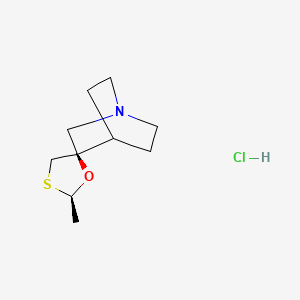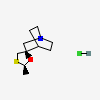Cevimeline (hydrochloride)
- Cevimeline hydrochloride
- 107220-28-0
- Cevimeline (hydrochloride)
- 124620-89-9
- (2R,5R)-2-methylspiro[1,3-oxathiolane-5,3'-1-azabicyclo[2.2.2]octane];hydrochloride
- Create:2005-08-08
- Modify:2025-01-18

- 2-methyspiro(1,3-oxathiolane-5,3)quinuclidine
- AF 102B
- AF 102B, (cis-(+))-isomer
- AF 102B, (trans)-isomer
- AF-102B
- AF102B
- cevimeline
- cevimeline hydrochloride
- Evoxac
- FKS 508
- FKS-508
- SNI 2011
- SNI-2011
- Cevimeline hydrochloride
- 107220-28-0
- Cevimeline (hydrochloride)
- 124620-89-9
- (2R,5R)-2-methylspiro[1,3-oxathiolane-5,3'-1-azabicyclo[2.2.2]octane];hydrochloride
- rac,cis-Cevimeline Hydrochloride Salt
- DTXSID10891421
- (2R,5'R)-5'-methyl-4-azaspiro[bicyclo[2.2.2]octane-2,2'-[1,4]oxathiolane] hydrochloride
- AF-102B
- AF-102B hydrochloride
- (+-)-cis-2-Methylspiro(1,3-oxathiolan-5,3')quinuclidine hydrochloride
- Cevimeline,hydrochloride salt
- cis-(+-)-2'-Methylspiro(1-azabicyclo(2.2.2)octane-3,5'-(1,3)oxathiolane) hydrochloride
- Spiro(1-azabicyclo(2.2.2)octane-3,5'-(1,3)oxathiolane), 2'-methyl-, hydrochloride, cis-(+-)-
- SCHEMBL838481
- GLXC-02517
- HY-70020B
- AKOS025311302
- AKOS030526237
- CS-4000
- MS-23364
- G17774
- EN300-1273269
- EN300-6497318
- (2R,3'R)-2-methyl-1'-azaspiro[[1,3]oxathiolane-5,3'-bicyclo[2.2.2]octane] hydrochloride
- 1428118-48-2
- rel-(2R,3'R)-2-Methyl-1'-azaspiro[[1,3]oxathiolane-5,3'-bicyclo[2.2.2]octane] hydrochloride
Cevimeline (annotation moved to)
Cevimeline Hydrochloride (annotation moved to)

P264, P270, P301+P316, P321, P330, P405, and P501
(The corresponding statement to each P-code can be found at the GHS Classification page.)
Aggregated GHS information provided per 39 reports by companies from 1 notifications to the ECHA C&L Inventory.
Information may vary between notifications depending on impurities, additives, and other factors. The percentage value in parenthesis indicates the notified classification ratio from companies that provide hazard codes. Only hazard codes with percentage values above 10% are shown.
Patents are available for this chemical structure:
https://patentscope.wipo.int/search/en/result.jsf?inchikey=SURWTGAXEIEOGY-GHXDPTCOSA-N
- CAS Common ChemistryLICENSEThe data from CAS Common Chemistry is provided under a CC-BY-NC 4.0 license, unless otherwise stated.https://creativecommons.org/licenses/by-nc/4.0/Cevimeline hydrochloridehttps://commonchemistry.cas.org/detail?cas_rn=107220-28-0
- ChemIDplusSpiro(1-azabicyclo(2.2.2)octane-3,5'-(1,3)oxathiolane), 2'-methyl-, hydrochloride, cis-(+-)-https://pubchem.ncbi.nlm.nih.gov/substance/?source=chemidplus&sourceid=0124620899ChemIDplus Chemical Information Classificationhttps://pubchem.ncbi.nlm.nih.gov/source/ChemIDplus
- EPA DSSToxCevimeline hydrochloridehttps://comptox.epa.gov/dashboard/DTXSID10891421CompTox Chemicals Dashboard Chemical Listshttps://comptox.epa.gov/dashboard/chemical-lists/
- European Chemicals Agency (ECHA)LICENSEUse of the information, documents and data from the ECHA website is subject to the terms and conditions of this Legal Notice, and subject to other binding limitations provided for under applicable law, the information, documents and data made available on the ECHA website may be reproduced, distributed and/or used, totally or in part, for non-commercial purposes provided that ECHA is acknowledged as the source: "Source: European Chemicals Agency, http://echa.europa.eu/". Such acknowledgement must be included in each copy of the material. ECHA permits and encourages organisations and individuals to create links to the ECHA website under the following cumulative conditions: Links can only be made to webpages that provide a link to the Legal Notice page.https://echa.europa.eu/web/guest/legal-notice(2R,3'R)-2-methyl-1'-azaspiro[[1,3]oxathiolane-5,3'-bicyclo[2.2.2]octane] hydrochloridehttps://echa.europa.eu/substance-information/-/substanceinfo/100.215.770(2R,3'R)-2-methyl-1'-azaspiro[[1,3]oxathiolane-5,3'-bicyclo[2.2.2]octane] hydrochloride (EC: 689-009-4)https://echa.europa.eu/information-on-chemicals/cl-inventory-database/-/discli/details/221019
- ClinicalTrials.govLICENSEThe ClinicalTrials.gov data carry an international copyright outside the United States and its Territories or Possessions. Some ClinicalTrials.gov data may be subject to the copyright of third parties; you should consult these entities for any additional terms of use.https://clinicaltrials.gov/ct2/about-site/terms-conditions#Use
- DailyMedCEVIMELINE HYDROCHLORIDEhttps://dailymed.nlm.nih.gov/dailymed/search.cfm?labeltype=all&query=CEVIMELINE+HYDROCHLORIDE
- Drugs@FDALICENSEUnless otherwise noted, the contents of the FDA website (www.fda.gov), both text and graphics, are not copyrighted. They are in the public domain and may be republished, reprinted and otherwise used freely by anyone without the need to obtain permission from FDA. Credit to the U.S. Food and Drug Administration as the source is appreciated but not required.https://www.fda.gov/about-fda/about-website/website-policies#linkingCEVIMELINE HYDROCHLORIDEhttps://www.accessdata.fda.gov/scripts/cder/daf/
- FDA Orange BookLICENSEUnless otherwise noted, the contents of the FDA website (www.fda.gov), both text and graphics, are not copyrighted. They are in the public domain and may be republished, reprinted and otherwise used freely by anyone without the need to obtain permission from FDA. Credit to the U.S. Food and Drug Administration as the source is appreciated but not required.https://www.fda.gov/about-fda/about-website/website-policies#linking
- National Drug Code (NDC) DirectoryLICENSEUnless otherwise noted, the contents of the FDA website (www.fda.gov), both text and graphics, are not copyrighted. They are in the public domain and may be republished, reprinted and otherwise used freely by anyone without the need to obtain permission from FDA. Credit to the U.S. Food and Drug Administration as the source is appreciated but not required.https://www.fda.gov/about-fda/about-website/website-policies#linkingCEVIMELINE HYDROCHLORIDEhttps://www.fda.gov/drugs/drug-approvals-and-databases/national-drug-code-directory
- NCI Thesaurus (NCIt)LICENSEUnless otherwise indicated, all text within NCI products is free of copyright and may be reused without our permission. Credit the National Cancer Institute as the source.https://www.cancer.gov/policies/copyright-reuse
- NLM RxNorm TerminologyLICENSEThe RxNorm Terminology is created by the National Library of Medicine (NLM) and is in the public domain and may be republished, reprinted and otherwise used freely by anyone without the need to obtain permission from NLM. Credit to the U.S. National Library of Medicine as the source is appreciated but not required. The full RxNorm dataset requires a free license.https://www.nlm.nih.gov/research/umls/rxnorm/docs/termsofservice.htmlcevimeline hydrochloridehttps://rxnav.nlm.nih.gov/id/rxnorm/260036
- Springer Nature
- PubChem
- Medical Subject Headings (MeSH)LICENSEWorks produced by the U.S. government are not subject to copyright protection in the United States. Any such works found on National Library of Medicine (NLM) Web sites may be freely used or reproduced without permission in the U.S.https://www.nlm.nih.gov/copyright.htmlMuscarinic Agonistshttps://www.ncbi.nlm.nih.gov/mesh/68018721Parasympathomimeticshttps://www.ncbi.nlm.nih.gov/mesh/68010277
- GHS Classification (UNECE)GHS Classification Treehttp://www.unece.org/trans/danger/publi/ghs/ghs_welcome_e.html
- PATENTSCOPE (WIPO)SID 403567468https://pubchem.ncbi.nlm.nih.gov/substance/403567468


 CID 313 (Hydrochloric Acid)
CID 313 (Hydrochloric Acid)